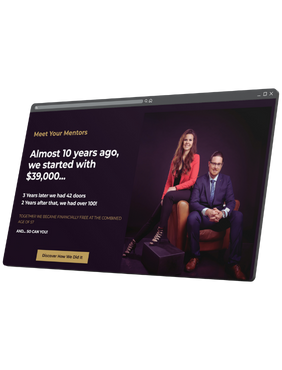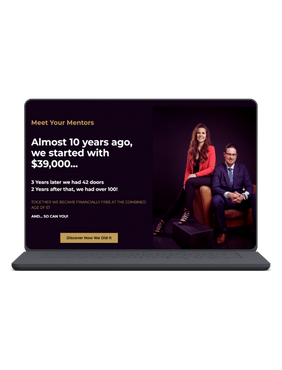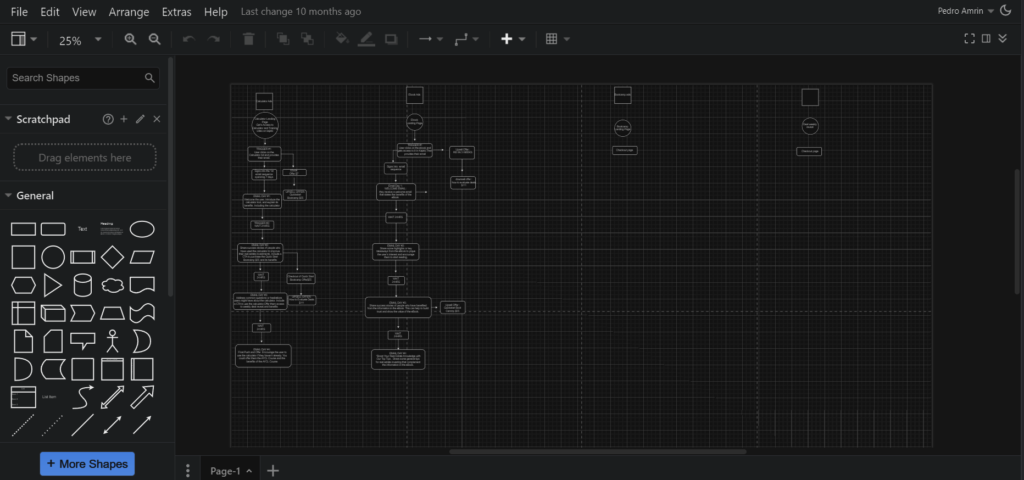
The Ultimate Blueprint.
JK Real Estate Partners Program for Aspiring
Realtors Start Investing in Real Estate in the U.S
Audience: JK Real Estate Partners’ proposed audience included individuals interested in real estate investment, particularly in U.S. properties. This target group encompasses first-time investors seeking guidance and education, experienced investors looking to diversify their portfolios, and foreign nationals aiming to invest in U.S. real estate without needing personal credit, proof of income, or U.S. citizenship.
Additionally, the project is designed to attract individuals seeking financial freedom through real estate investments, people looking to boost their monthly cash flow or supplement their income, and retirees aiming to secure their retirement through real estate investments.
Responsibilities: instructional design (action mapping, storyboarding, mockups, prototype, full build), visual design (website design, landing page design), customer journey mapping, sales/ lead generation.
Tools Used: Kajabi, Flow chart, PowerPoint, Google Docs, Adobe Photoshop, Canva, Draw.io

The Problem and Solution
The identified problem for JK Real Estate Partners involved addressing the diverse learning needs and goals of its audience, which included first-time investors, experienced investors, foreign nationals, and retirees. This necessitated the creation of engaging, accessible, and personalized content across various formats like webinars, online courses, and guides to cater to different preferences. Ensuring foundational knowledge for beginners and advanced content for seasoned investors was crucial, as was providing clear legal and financial information for foreign nationals. Continuous engagement through community building and feedback mechanisms, along with establishing trust and credibility through expert-led content and transparency about the investment process, was essential to enhance the educational experience and support the business’s growth.
To address the diverse learning needs and goals of JK Real Estate Partners’ audience, we used Kajabi, flow charts, PowerPoint, Google Docs, Adobe Photoshop, Canva, and Draw.io cohesively. We started by identifying audience segments and their specific learning objectives using a flow chart on Draw.io. We then developed engaging content tailored for each segment, utilizing Kajabi for interactive courses, webinars, and community forums, while PowerPoint enhanced presentations with visually appealing infographics and interactive elements. Google Docs supported detailed guides, e-books, and feedback forms to gather insights and maintain process documentation. Adobe Photoshop and Canva ensured consistent branding with engaging visuals, banners, and social media posts. This integrated approach ensured comprehensive content delivery, continuous engagement, and regular updates based on feedback, ultimately enhancing the educational experience for all audience segments.
My Process
To bring this project to life, I leaned on a variety of tools and platforms. Using Kajabi, I set up courses with modules focusing on real estate investment for different audience segments and delivered engaging content through videos, quizzes, and downloadable resources. I also established a community forum for interaction and support. With Draw.io, I created flow charts for audience segmentation, mapping specific content to each segment and outlining continuous engagement strategies. PowerPoint was employed to develop visually appealing presentations and infographics, simplifying complex concepts and incorporating interactive Q&A sections. Google Docs facilitated the creation of detailed guides and e-books, maintained documentation of the instructional design process, and distributed feedback forms to gather insights. Adobe Photoshop and Canva ensured consistent branding through the design of engaging visual content such as banners, social media posts, and course thumbnails.
To further enhance engagement and retention, I integrated email campaigns into the process. These campaigns were designed to nurture leads, provide regular updates, share valuable content, and gather feedback. Automated email sequences were set up for new subscribers, guiding them through the learning journey with tailored messages for each audience segment. This comprehensive approach ensured a cohesive and impactful educational experience for all audience segments, fostering continuous engagement and building a strong community of real estate investors.
Action Map
I consulted with an experienced real estate investment advisor as my SME. Together, we created an action map that outlined common challenges faced by new and seasoned investors alike. Through this process, we noticed a common theme: the need for clear, accessible education on U.S. real estate investments. This insight allowed us to create the learning goal we wanted to achieve with our educational materials: investors will understand and follow best practices for U.S. real estate investments to maximize their returns and minimize risks.
From there, the SME narrowed down the top three high-priority actions that would serve as the foundation for our educational content: understanding legal and financial requirements, implementing effective investment strategies, and maintaining continuous market analysis.
These actions were designed to be incorporated into a comprehensive learning platform using Kajabi, supplemented by visually engaging presentations and infographics in PowerPoint, detailed guides and feedback mechanisms in Google Docs.

Full Development
After collecting feedback and applying several iterations to refine the approach, the project consists of 120+ educational modules and supporting materials designed to guide investors through the complexities of U.S. real estate investment. The development process was comprehensive and multifaceted, ensuring that every aspect of the investor’s learning journey was addressed.
In-depth Process:
~Audience Segmentation and Content Mapping: We began by using Draw.io to create an action map, segmenting the audience into first-time investors, experienced investors, foreign nationals, and retirees. This helped us tailor content specifically to each group’s needs and learning objectives.
~Content Creation: Utilizing Kajabi, we developed over 120 modules that included videos, quizzes, downloadable resources, and interactive elements. This platform allowed us to deliver engaging and structured educational content effectively.
~Visual Design and Presentations: Adobe Photoshop and Canva were crucial for designing visually appealing materials such as banners, social media posts, course thumbnails, and infographics. PowerPoint was used to create detailed presentations for webinars and workshops, simplifying complex concepts with interactive elements.
~Guides and Documentation: Google Docs was employed to write comprehensive guides and e-books, maintain detailed documentation of the instructional design process, and create feedback forms to gather insights and continuously improve the content.
~Community Engagement and Feedback: Kajabi’s community forum feature enabled interaction and support among investors. We also implemented feedback mechanisms to gather user input and make iterative improvements.
~Email Campaigns: A key aspect of the project was developing scripted email campaigns to nurture leads and maintain engagement. We crafted personalized email sequences for each audience segment, providing regular updates, valuable content, and calls to action. These campaigns were designed to guide investors through their learning journey, from initial interest to active participation and investment.
Reflection & Takeaways
A) Favourite Features:
Some of my favourite features of this project include:
_Interactive Modules: The use of Kajabi’s interactive elements, such as quizzes and videos, made learning engaging and effective.
_Visually Appealing Designs: The visual content created with Adobe Photoshop and Canva ensured consistent branding and enhanced the overall user experience.
_Comprehensive Guides: The detailed guides and e-books in Google Docs provided thorough educational resources that investors could refer to at any time.
_Community Forums: The community feature fostered a sense of belonging and support among investors, promoting continuous engagement.
_Effective Email Campaigns: The well-scripted email campaigns played a crucial role in nurturing leads, providing valuable updates, and keeping the audience engaged throughout their investment journey.
B) Timing is crucial: One of the key lessons learned from this project is the importance of timing. The ability to launch educational modules, email campaigns, and community engagement activities at the right time can significantly impact the project’s success. Ensuring that content is released promptly, particularly in response to market trends or feedback from investors, helps maintain momentum and keeps the audience engaged. Coordinating the different phases of the project, from content creation to deployment, required meticulous planning and scheduling to align with the needs and expectations of the target audience.
C) Appreciation for the process: Working on this project has deepened my appreciation for the instructional design process. Each phase, from initial audience segmentation and content mapping to the development and delivery of engaging educational materials, highlighted the complexity and intricacy involved in creating effective learning experiences. Collaborating with the SME provided valuable insights, and the iterative nature of collecting feedback and making improvements underscored the importance of adaptability and continuous improvement. The integration of various tools—Kajabi, Draw.io, PowerPoint, Google Docs, Adobe Photoshop, Canva, and scripted email campaigns—demonstrated the power of a cohesive, multi-platform approach in delivering a comprehensive and impactful educational program.
Overall, the project reinforced the value of strategic planning, collaboration, and iterative refinement in achieving successful outcomes, leaving a lasting impression on how to effectively educate and engage a diverse audience in the real estate investment sector.
